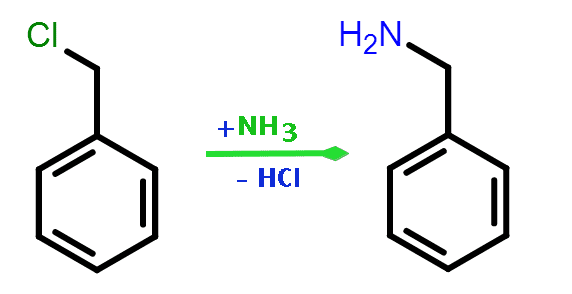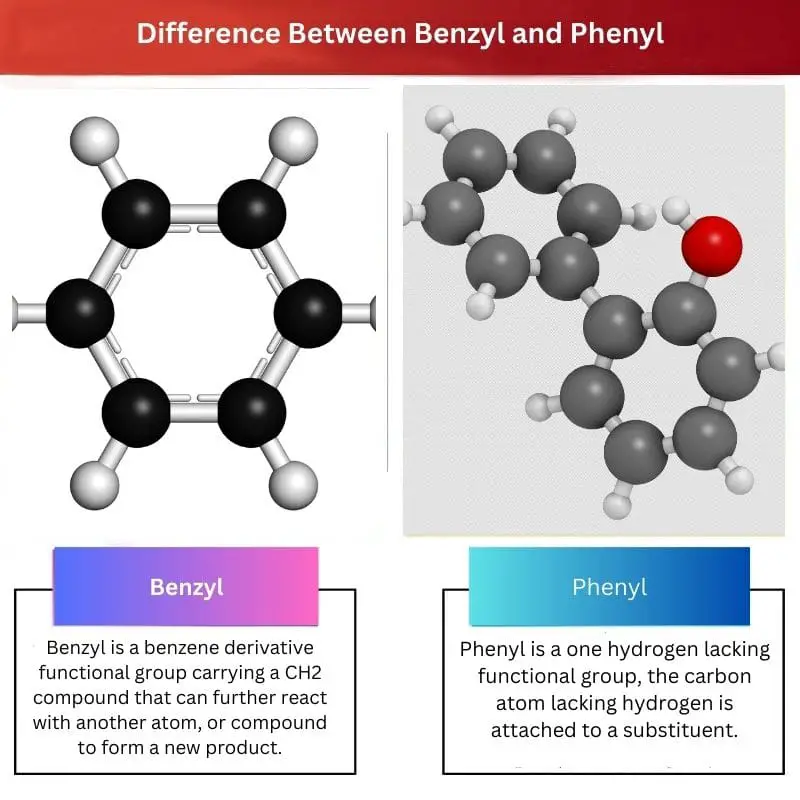Organic Chemistry is the most diverse and important field of study. It not only makes understanding life easier but also takes us to the chemistry involved in forming particles at a minute level.
The compounds in organic chemistry react with different atoms, reagents, and other compounds to form a completely different product with different characteristics than before.
The Carbon chain is one of the primary bases of identification in organic chemistry, and the chain forms a round circular structure by forming specific bonds.
Benzene ring forms the most important compound, ring-shaped with 6 carbon atoms. The carbon atoms are further bonded with Hydrogen atoms.
Replacing subsequent Hydrogen atoms with different functional groups gives rise to a different compound.
Benzyl and Phenyl show similarity in structure as both have a ring-shaped structure, that is, of benzene, but still form different functional groups.
Key Takeaways
- Benzyl is a chemical substituent from toluene, consisting of a phenyl ring attached to a CH2 group (C6H5CH2-).
- Phenyl is a chemical substituent composed of a benzene ring minus one hydrogen atom (C6H5-), which can bond with other atoms or groups.
- The key difference between benzyl and phenyl lies in their molecular structure: benzyl contains an additional CH2 group, while phenyl is solely the benzene ring minus one hydrogen.
Benzyl vs. Phenyl
Benzyl is a chemical compound containing a benzene ring attached with methyl group. It comes before an organic group to show the presence of a particular group. Phenyl is a chemical compound involved with a benzene ring without any additional substituents.

Comparison Table
| Parameter of Comparison | Benzyl | Phenyl |
|---|---|---|
| Definition | Benzyl is a benzene derivative functional group carrying a CH2 compound that can further react with another atom, or compound to form a new product. | Phenyl is a one hydrogen lacking functional group, the carbon atom lacking hydrogen is attached to a substituent. |
| Molecular Formula | The molecular formula of Benzyl is C6H5CH2 | The molecular formula of phenyl is C6H5 |
| Reactivity | The reactivity is high because of the weak bond between C-H atoms. | The energy required to break the C-H bond is very high, this the reactivity is low. |
| Abbreviation | Bn is used terminology while working and reacting with other compounds. | It is abbreviated as Ph. |
| Advantage | They are used extensively as a protecting group for carboxylic acids. | They are used in medicine and also to stop oxidation and reduction. |
What is Benzyl?
Benzyl is a derivative of Benzene with few alterations. The ring is abbreviated as “Bn.”
It is a functional group, thus, responsible for the chemical properties of the molecules they form.
The chemical composition of Benzyl consists of Carbon and Hydrogen atoms arranged in the sequence attached to a CH2 group.
The chemical formula is C6H5CH2; thus, benzyl is derived from Toluene which is C6H5CH3, forming a monovalent radical.
The bonds of Carbon and hydrogen are not strong. Thus, the external energy requirement in breaking the bond is low, around 90 Kcal/mol, and changes further for Methyl and ethyl CH bonds.
The reactivity is high because of weak bond energy; the compounds formed by it are benzyl methyl, benzylamine, etc.
They are used in organic science to protect the carboxylic acids and alcohols.

What is Phenyl?
Abbreviated as Ph, Phenyl is a cyclic functional group derivative of the Benzene ring and possesses certain properties similar to that of Benzene.
The molecular weight is 77g mol-1, and the formula is C6H5.
Due to the lack of one hydrogen atom, a benzene Phenyl can easily bond with a subsequent atom, molecule, or another phenyl group.
The energy required to break the bond is very high because of the strong atomic bond; the necessary energy to break the bond is 113 Kcal/mol; it varies with the bonds formed with different atoms; for example, with Methyl attached, the dissociation energy is 105 Kcal/mol while with ethyl the energy requirement is 101 Kcal/mol.
The reactivity of Phenyl is very low because of strong Carbon and Hydrogen bonding. Like Benzene, even Phenyl is sp2 hybridized.
The properties of phenyl change with the change in substituents; the substituent can be a donor or electrons and withdraw too.
The compounds with phenyl as a functional group are used for medicinal purposes. Allergies and cholesterol-related problems can be treated with Atorvastatin and Fexofenadine-containing phenyl.
Phenyl is also used daily as a domestic disinfectant and for sanitation purposes in the home, schools, hotels, or anywhere necessary.

Main Differences Between Benzyl and Phenyl
- The main difference between Benzyl and Phenyl is that Benzyl is directly derived from Toluene and lacks a hydrogen atom. Phenyl is a benzene ring lacking a Hydrogen atom; both are functional groups.
- The chemical formula of Benzyl is C6H5CH2, whereas that of Phenyl is C6H5
- Benzyl is a reactive organic compound due to the low dissociation energy between the bonded carbon and hydrogen atoms, but the bond in phenyl is stronger and thus less reactive.
- In Benzyl, the energy required to break C-H bonds is must 90 kcal/mol, whereas Phenyl requires very high energy to break the bond the energy required is 113 kcal/mol.
- Benzyl is abbreviated as Bn, whereas a phenyl compound is simplified to Ph.for. For example, benzyl alcohol is represented as BnOH, whereas Benzene can be represented as PhH.

- https://www.sciencedirect.com/science/article/pii/S1386142512006051
- https://www.sciencedirect.com/science/article/pii/S0031942205004206